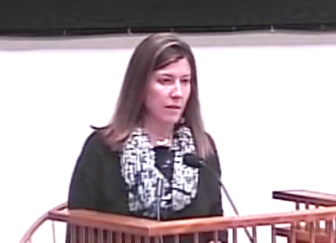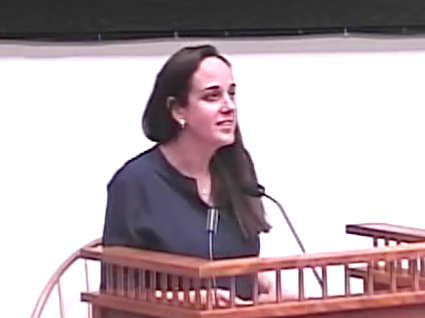These are two of the statements from elementary school parent teacher organizations about the proposed education budget to the Board of Education at Thursday’s public hearing on the budget.
First Statement: Curriculum

Sara Goertel
Good Evening. My name is Sara Goertel. I have 3 of my 4 children at Tokeneke school. I’m going to speak this evening about initiatives important to the parents of elementary school students.
The three initiatives I would like to focus on tonight are: Professional Development, Library/Maker Spaces, and transitions from Pre-K to Kindergarten and from 5th to 6th Grade.
Professional Development:
As parents, we believe the most important factor contributing to our children’s success is the quality of teaching. We strongly support the continued investment in the professional development of our educators. We want our teachers exposed to evidence-based “best practice” teaching strategies and the most effective methods for reaching all different types of learners in the classroom.
- We agree with the focus of spending this year on science, social studies, gifted education, math and health education, as well as specific training for priority content areas (Orton-Gillingham, Wilson, SRBI training, etc.)
- We would like to encourage the administration, through this professional development and other efforts, to continue to strive for consistency across schools: pacing of curriculum, amount and type of homework, etc.
- At the same time, we expect this professional development to help strengthen practices for differentiation within classrooms/per student.
- Along with investments in professional development, parents would like to see measurement, tracking and reporting on the success of these initiatives.
Let’s continue to build our schools as places where both teachers and students learn and grow.
Library/Maker Spaces:
We are excited about the possibility of reimagining our libraries as 21st century maker spaces.
- What is the vision for what these LLCs or maker spaces will eventually become? Do we have models for schools doing this successfully that we are looking to emulate? By beginning with the end in mind, we can better map how to get there together.
- Additionally, we need to have some discussion on how and when the elementary school children will be able use the libraries. We expect our kids are going to be very excited about these new spaces! Will they be able to go before and/or after school? Will there be curriculum to support the spaces? Will the maker spaces support the curriculum?
We look forward to working with you to further define the plans make these spaces a reality.
Transitions:
Parents would like to keep looking for ways to help our children make the transitions from pre-school to Kindergarten and from Elementary School to Middle School more seamless.
- Key areas of concern in the Pre-K to K transition seem to be: parent expectations regarding communication, planning coordination between ELP and the receiving team, the need to better educate parents about the individual plans for their children, and the general expectations for the new setting.
- Regarding the 5th to 6th Transition, we believe that having consistent practices and expectations across the five schools will help all new 6th graders start on the same path for success.
- We would like to see — not more!– but more thoughtful homework assignments, emphasis on time, project management, and study skills, and better preparation for the rigor they’ll face at Middlesex.
- We are excited by new efforts like having the 5th graders attend the Middlesex musical dress rehearsal to start getting the kids in the building sooner.
- We encourage more ideas like this as it not only makes Middlesex less of a mystery to the kids but also gives them another chance to feel like the young adults they are becoming.
Parents want to know that instructional initiatives are based on research and best practice data; include a comprehensive professional development plan; and provide clear measures of success by which parents can understand the progress of their child. We look forward to more communication on the success of these initiatives.
Second Statement: Capital Projects
Hello. My name is Sara Parent. I have two children at Holmes School. I would like to speak to you tonight about our elementary school facilities.
Darien is a vibrant community that places a high value on academic excellence and we applaud your efforts to invest in our school facilities. We fully support all of the individual capital projects laid out in the current budget.

Sara Parent
However, we view these as only a starting point and urge you to look at the bigger picture. We, the parents of Darien public school students, feel the capital conversation needs to have a much larger focus than just what is currently proposed.
Public school buildings are a part of a community’s permanent infrastructure—usually lasting for many generations. The school building itself—the place where people and programs converge—can support quality education, or obstruct it.
The school facility is much more than a passive location of the educational process. It is, rather, an integral component of the conditions of learning.
Substandard school buildings reflect poorly on the people and programs that are housed in them. Conversely, attractive, well maintained, educationally appropriate school facilities support teaching and learning and enhance the community.
The list of parent concerns regarding our school facilities is quite extensive. How many more years to do our children need to spend in what most of us would deem sub-par building facilities, given the high standard we apply to other aspects of our lives and that of our children’s lives? What is the minimum standard that we have for our school facilities? How many more years must teachers be in classrooms that are well below appropriate square footage?
School facilities affect teacher recruitment, retention, commitment, and effort — all of which directly affects our children.
FULL COVERAGE of the Board of Education public hearing:
Topics at Education Budget Hearing: DHS Cafeteria, Dept Chairs, Guidance Counselors
Council of Darien School Parents: Budget Statements at the Board of Ed Public Hearing: PART 1
Budget Statements on High School, Middle School at the Board of Ed Public Hearing: PART 2
Elementary School PTO Statements on the Budget at the Board of Ed Public Hearing: PART 3
Special Education Parents Statements at the Public Hearing on the Schools Budget: PART 4
Additionally, many of our elementary schools have a heating problem. The drastic variation in temperature between classrooms in the same building is shocking.
Some basic level of heat control must be a priority. With regards to air conditioning, while we understand that getting central A/C in all of our buildings is not currently possible, it is worthwhile to point out that there are in fact extreme temperature issues within many of the elementary school classrooms in September and August and again in May and June.
We strongly believe that this lends itself to a lack of productivity and learning from the students and teachers. If A/C is not possible, certainly window units in every class room must be an option, and we believe that an upgrade to our schools’ wiring and power issues needs to be immediately addressed to make this possible.
The portables are an enormous safety concern. To use the bathroom, young children must leave the portable and walk outside,unsupervised, in order to get to the main building.
These portables have also far surpassed their life expectancy, and are no longer a conducive learning space. They also pose a vulnerable risk in the event of a lock down, given their location.
Board of Education – Budget Public Hearing 2-2-17 from Darien TV79 on Vimeo.
The learning experience in portables is compromised by poor lighting, erratic temperatures and/or noisy heating and air conditioning. Our portables were meant to be temporary yet they are still used as if they were part of the brick and mortar building.
It has also become clear through these capital discussions, that there is not parity amongst our schools as it relates to facilities. This will be further exacerbated with the proposed rebuild of Ox Ridge School.
Soon, Darien will have two elementary schools with heating and cooling, an updated look and feel, best practice room sizes, along with many other aspects of a new building.
The three old buildings wouldn’t even come close to the standard of the other two. While we know these three other schools do not need a complete rebuild, we want to be sure that the look and feel of all the elementary schools will be on par with each other.
_________
Like this article? …
- Sign up for the Darienite.com weekday newsletter.
- Like Darienite.com on Facebook.
- Follow Darienite.com on Twitter.
_________
Parity should also consider what functional spaces exist in each building. For example, specials teachers – such as foreign language, art and music – should have their own dedicated classrooms at all of our schools, each and every year.
The new Ox Ridge will be built with a more technology-driven library/makerspace. It will be critical for the remaining schools to be brought up to the same standard.
With the proposal of multiple new building developments in our town, we have to be prepared for enrollment to rise. Given the uncertainty we encourage the board to think ahead and plan for what may be coming rather than building only what we need right now.
We must avoid the mistakes of recent projects where we found ourselves overcapacity within a year of opening the high school and Tokeneke. Furthermore, the common rooms/cafeterias in our elementary schools which are used for school assemblies are small and, in some cases, not even large enough to accommodate the current student population.
Also, at present, the ELP program has eight classes spread out over three elementary schools, which is inefficient for educational cohesiveness and wasteful from a cost perspective. Having a dedicated space to house the entire ELP program, would alleviate these concerns.
We are aware that architects have drafted drawings to start this process, however, we would like to see a more definitive plan and timeline for the overall project. Five more years of small capital fixes ignores the greater issue of existing space constraints and poor facilities conditions and is unacceptable.
We would like a plan from the Board that addresses many of the issues outlined here. While improving facilities comes at a financial cost, we believe the benefits of such an investment will surpass the initial fiscal burden.
When the positive impacts of facility improvements are felt by the teachers and students, the rewards far outweigh the cost. It would also be prudent to take advantage of low interest rates as rates will likely rise over the next few years.
Whatever the future holds for education, our buildings need to adapt to meet these demands. We have a vision of new and improved schools, looking beyond what currently is, to imagine what could — and should — be.


Pingback: Budget Statements on High School, Middle School at the Board of Ed Public Hearing: PART 2 - DarieniteDarienite